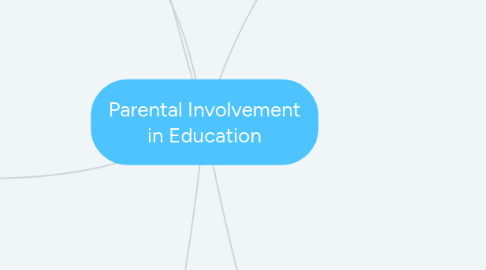
1. Advantages of Involvement
1.1. Social Capital (Hill & Taylor) (Journal 1)
1.2. Social Control (Hill & Taylor) (Journal 1)
1.3. Can shrink or close gaps in achievement (Dearing,Kreider, Simpkins, & Weiss) (Journal 4)
1.4. parent academic involvement was positively related to achievement for African Americans, but not for European Americans (Hill et al.) (Journal 5)
1.5. The more involved parents are in children's learning, the more motivated children are to do well in school (Cheung) (Journal 6)
1.5.1. Promotes self-regulated learning, which increases achievement
2. Theory
2.1. Bronfenbrenner ecological theory
2.2. Epstein's theory
2.3. Bourdieu's theory on cultural capital
2.4. Self Determination theory (Journal 6)
2.4.1. Children take on their parents high expectations as their own
3. Implications
3.1. Pre-teacher programs should include information on how to build a strong family-school partnership
3.1.1. “All teacher participants indicated that they received no formal training in their teacher preparation programs regarding the establishment of family–school partnerships or effectively resolving conflict with parents” (Lasater, 2006, p. 250). (journal 10)
3.1.2. “More than half of the teachers (51.6 %) pointed out, that they would need additional training in the area of problem solving and conflicts when parents have to be included” (Kalin & Steh, 2010, p. 4927). (Journal 13)
3.2. School outreach (Galindo & Sheldon) (Journal 3)
3.2.1. teachers can extend invitations to and communicate with families more frequently
3.2.2. “Researchers have shown that schools are critical influences on family involvement. Parents are more likely to be involved in their child’s education when the school or teachers make a stronger effort to engage them in their children’s learning” (Galindo & Sheldon, 2012, p. 91). (Journal 3)
3.3. “Implications for practice include the need for schools to view family involvement over the long term, ideally creating an educational environment that increases the involvement of families that are less involved, and then helps sustain that involvement across elementary school” (Dearing, Kreider, Simpkins, & Weiss, 2006, p. 662). (Journal 4)
4. Teacher Barriers
4.1. “Educator barriers include: fear of conflict with parents, concerns about families’ abilities to assist with school-related issues, negative communication with families regarding a child’s academic progress, and difficulty seeing parents as partners in the educational process” (Lasater, 2006, p. 240). (Journal 10)
5. Parental Barriers
5.1. Socioeconomic Status
5.1.1. Busy work schedules (night shifts), less time to help with homework or attend school events
5.1.1.1. “The main barrier to parents and carers getting more involved in their child’s school life is work commitments, in the parents’ view: just over half (53%) say work commitments stop them getting more involved in their child’s school life, especially men (62%) and those working full-time (71%)” (Moon & Ivins, 2004, p. 4) (Journal 9)
5.1.2. “Teachers reported significantly higher academic achievement among students not living in poverty, European American students, and students with more educated parents” (Lee & Bowen, 2006, p. 209). (Journal 2)
5.1.3. Involvement is most meaningful for low income/at risk families (Dearing,Kreider, Simpkins, & Weiss) (Journal 4)
5.1.4. “There was an achievement gap in average literacy performance across the study between children of more and less educated mothers if family involvement levels were low, this gap was nonexistent if family involvement levels were high” (Dearing, Kreider, Simpkins, & Weiss, 2006, p. 661). (Journal 4)
5.1.5. Parents from the minority group and parents who have a low education background have a different perception of what it means to be involved (Moon & Ivins) (Journal 9)
5.1.6. Parents view school negatively (Journal 11)
5.1.7. Parents are less comfortable around teachers (Journal 11)
5.1.7.1. “Hispanic and Asian parents who were not born in the USA were almost three times more likely to feel unwelcome at their children’s school than white Americans” (Ankrum, 2016, p. 168). (Journal 11)
5.2. Parent's education background
5.2.1. Educational expectations may vary
5.2.2. Increases "Human Capital" (Coleman) (Journal 8)
5.3. Family structure
5.3.1. There was an achievement gap in average literacy performance between children of more and less educated mothers (Dearing,Kreider, Simpkins, & Weiss) (Journal 4)
5.4. Parent-teacher conflict
5.4.1. If a conflict arises and is not solved, parents tend to detach from their child's schooling (Lasater) (Journal 10)
6. Definition
6.1. Hill and Taylor (2004) define parental school involvement as, “consisting of the following activities: volunteering at school, communicating with teachers and other school personnel, assisting in academic activities at home, and attending school events, meetings of parent-teacher associations (PTAs), and parent-teacher conferences” (p. 161). (Journal 1)
6.1.1. School Involvement
6.1.1.1. Types of School Involvement
6.1.1.1.1. Attending school events
6.1.1.1.2. volunteering
6.1.1.1.3. PTSA Meetings
6.1.1.1.4. Attending parent-teacher conferences
6.1.1.2. Increased school involvement predicted improved child literacy (Dearing,Kreider, Simpkins, & Weiss) (Journal 4)
6.1.2. Home Involvement
6.1.2.1. Helping with homework
6.1.2.1.1. In regards to helping with homework… “Three quarters believed this was extremely important (76%). The proportion saying this was higher, the lower the school year of the child and the younger the age of the parent/carer. It was also slightly higher among females, those not working and Asian respondents” (Moon & Ivins, 2004, p. 40) (Journal 9)
6.1.2.2. Communicating with teacher via phone, email, in their child's work, etc...
6.1.2.2.1. Communicating challenges and successes
6.1.2.2.2. Over 85% of the participants believe that parent communication plays a vital role in the success of the students (Ankrum) (Journal 11)

